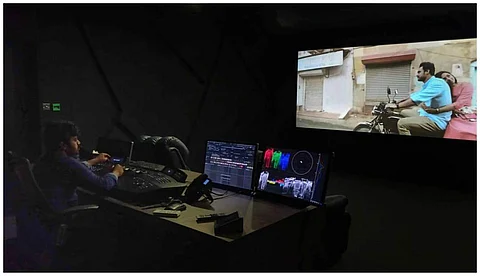

The unforeseen second wave of the Covid-19 pandemic has brought the nation to a screeching halt again. For the film industry that had just begun to smell normalcy after standing still for several months, the announcement of new lockdown regulations has come as a challenge. While film shootings have been disrupted, film professionals supervising the sound and colour grading processes in the post-production phase are finding inventive ways to get by. “Unlike editors and VFX artists, who can work individually on their personal machines, dubbing mandates the physical presence of the actors and voice artists in the recording studio, thereby making our job much harder during the lockdown,” says Vignesh Guru, who has worked as a dubbing engineer on numerous films including Karnan and Sulthan, two major Tamil films to hit the marquee weeks before theatres shut down.
Revealing that dubbing activities have been kept on hold for the time being to abide by state-imposed lockdown regulations, Vignesh explains that his team has adapted novel practices to compensate for the reduced productivity. “Online dubbing has grown in prominence over the last few years. We have now used it on the second season of The Family Man, whose cast features several Tamil artists, and with the regulations forbidding them from travelling to Mumbai, their dialogues were instead recorded in Chennai. The makers and diction coaches joined over a Zoom call to guide the actors during the recording process. This practice is likely to become a norm,” says Vignesh, whose work on Pa Ranjith’s Sarpatta Parambarai, the late SP Jananathan-directorial Laabam, and Sundar C’s Aranmanai 3 remains temporarily halted.
Finding the going even more difficult is T Uday Kumar, an audiographer and mixing engineer, whose work, admittedly, doesn't allow for easy alternatives as the “sound mixing process requires the team to operate in studios with industry-approved sound systems”. The curbs have compelled his team to discontinue work. “Considering our mixing standards and the specifications which are calibrated for theatres, we need a workstation configured with 5.1-channel sound system. Once our work is over, we present our final sound mix to the filmmaker with theatre-like sound specifications to help them arrive at better judgment. Naturally, they approve the final mix only when they are assured that the audience will hear the film the way it was intended. The temporary closure of studios has resulted in our workflow getting hindered,” says Uday, whose sound mixing work on films like Laabam and Nani-starrer Tuck Jagadish
Uday, known for working on films such as Vada Chennai, Asuran, Saaho, and Viswasam, to name a few, points out that the pandemic has adversely affected the incomes of sound technicians. “In a normal year, we would work on about 90 films. In 2020, this number plummeted to 60, and this causes financial burden. Even if the government permits us to work, we will have to wait for the theatres to reopen because producers tend to clear our dues just before the release of the film after we deliver the final output,” shares Uday.
Sound designer and mixer Suren G agrees that it’s arduous for sound technicians to maintain their workflow without access to workstations in studios. “There are temporary solutions like adopting a basic stereo sound system to work from home, but we can hardly replicate the experience of working in a theatre equipped with Dolby Atmos, which ensures that minute details don’t go unnoticed,” shares Suren, whose filmography includes popular films like Darbar, Psycho, Soorarai Pottru, and Karnan. The sound designer adds that the foley process (by which everyday sound effects are recorded) has taken a beating. “Creating the ambience of the film and recording sound through foley are major responsibilities for a sound designer. Our large library of pre-recorded sound effects—like rain, sounds of nature, vehicles, fights...— comes in handy during this time. However, the lockdown restrictions still come as a major blow because we need at least five foley artists to help us record footsteps,” says Suren, whose upcoming films include Sivakarthikeyan's Doctor, Vija
These are challenges that affect colourists too. Prasath S, who worked as a colourist on Nizhal, Mandela, Sulthan, and the upcoming web series, November Story, says, “We need a large screen to comprehend the colour scheme of a film in its truest form. We work on a system called Baselight which integrates a massive console, a high-quality projector, and a big screen. Theatres screen films using direct, frontal light from the projector, whereas films on streaming services use the backlight of the electronic devices to present the picture, and so, they tend to be brighter. Owing to the fundamental difference between these two mediums, the format of the final deliverables needs to be customised, even if the overall working style and technical requirements for colour grading remain unchanged. Without a professional console, it's hard to make any progress in the colour correction process” says Prasath, whose filmography includes popular films like Kaththi, Theri, Kaala, and Kabali, to name a few.
The colourist, who was compelled to suspend work on Sarpatta Parambarai and the upcoming Prithiviraj Sukumaran-starrer Bhramam, add
It’s easier for the editors
The lockdown impact on editors has been less severe. Due to the relatively adaptable demands of editing, editors seem to have adapted to the new normal and shifted workstations to their homes. Anthony L Ruben, who is currently working on Rajinikanth’s Annaatthe and Sivakarthikeyan’s Ayalaan, say
Editor TS Suresh, known for his work in Maya and Thamizh Padam 2, seconds Ruben’s point and adds, “I feel that the coordination among various departments has grown transparent during the quarantine as we all maintain a common excel sheet to keep track of the progress. With the entire workflow migrating to the cloud, procuring deliverables from VFX and other departments is now free of hurdles and has, in fact, increased our productivity.”